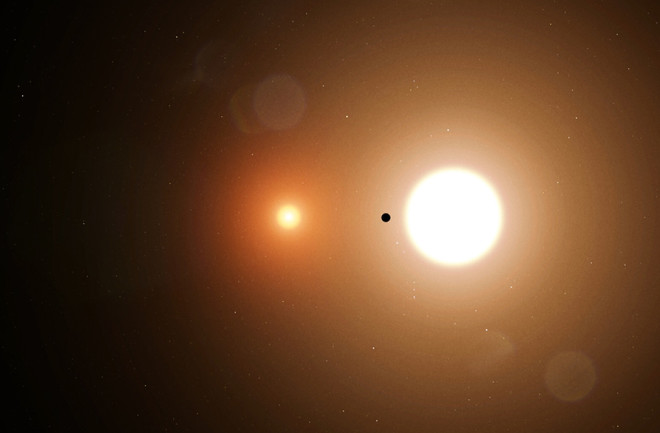Despite the seemingly-infinite vastness of the cosmos, Earth is the only place known to harbor life. As such, humans have long wondered whether our world is the only place where life has emerged — a process known as abiogenesis.
A new study may offer some tantalizing clues. Planetary scientists from the Max Planck Institute for Solar System Research in Germany showed that the metallicity of stars, or how much metal a star contains, is an important factor in our ongoing search for complex life elsewhere in the universe, according to a paper recently published in Nature.
What's more, the scientists suggest that planets surrounding metal-poor stars should be considered the best targets for finding complex life on another world.
What Conditions Sustain Life in the Universe?
Life — at least, the complex, multicellular life we are familiar with — requires oxygen. Our oxygen rich atmosphere, which is in part the result of the activity of life on the surface of our planet, is responsible for the formation of our ozone layer.
The Earth’s ozone layer provides a crucial barrier to the harmful ultraviolet radiation (UV) emitted by the Sun, without which, multicellular life might not have come to dominate the surface of our rocky, watery world.
Read More: Earth-Like Exoplanets Must Have Water, Paper Says
How Much UV Radiation Does a Star Produce?
How much UV a star produces (and therefore how UV planets are exposed to) depends on the temperature of said star, or so scientists thought. In the new study, the team found that the metallicity of a star affects the type of UV a star emits.
And, paradoxically, even though metal-rich stars emit less UV than their metal-poor cousins, metal-rich stars still expose Earth-like planets in their orbit to more harmful radiation.
This is due to the distribution of different types of UV radiation that metal-rich and metal-poor stars emit. The thickness of ozone layers in planets with oxygenated atmospheres, for example, is proportional to the ratio of ozone-producing radiation to ozone-destroying radiation, says Anna Shapiro, a scientist at the Max Planck Institute for Solar System Research who led the study.
"This ratio decreases with metallicity," adds Shapiro, meaning that the ratio is higher for metal-poor stars than for metal-rich stars.
Read More: How Many Ways Can the Sun Kill Us?
How Have Stars Changed Over Time?
The first stars in the universe were composed (almost entirely) of hydrogen and helium. They survived by fusing hydrogen together, emitting vast amounts of energy simultaneously.
As these primordial stars aged, they needed to start fusing heavier and heavier elements together until the elements in their cores created iron. The temperatures and pressure inside these stars weren’t enough to sustain the fusion of iron, causing the star to supernova, scattering heavy elements into their galactic neighborhoods.
This cycle has been repeating since the first stars emerged in the early universe. And, as such, the distribution of elements in the universe has gotten greater, with metals becoming a regular ingredient in the composition of stars today.
“With, time supernovae enrich the universe with heavy elements,” adds Shapiro.
Read More: Ancient Humans and Their Early Depictions of the Cosmos
What Do Metallic Stars Have to Do With Life?
The new research raises two intriguing possibilities — both of which have their own set of implications for the distribution of life in the cosmos, as well as the evolution of life on Earth.
Life In the Cosmos
For starters, the study authors think that life which emerged early in the universe may have faced less radioactive stress than life that emerged later, as stars that formed in the early universe were more metal-poor.
“Our study shows that early life in the early universe experienced less radiative stress," sayss Shapiro. "But it is rather difficult to say whether it was more common or not because there are other criteria that could affect habitability."
Read More: Tools to Understand the Cosmos Are Right Under Our Feet
Life Under UV Protection
The second explains why it is likely the first life to emerge on Earth was limited to the ocean and sheltered areas on the Earth’s surface.
“Because of the absence of a protective ozone layer, the first life had to live under UV protection," says Shapiro, such as that created by different bodies of waters, shadowing from rocks and the formation of pigment among various life forms. "The only source of oxygen was aquatic photosynthesis performed by UV-tolerant cyanobacteria and algae. But they can accumulate only a limited amount of oxygen."
Read More: Does Blue Light Damage Skin?
Is There Life on Other Planets?
The research provides astrobiologists with another important parameter to consider in their ongoing mission to identify life on another planet. Indeed, it's also possible that as the universe gets older, and as more stars become more metal rich, the probability of life emerging on terrestrial planets gets smaller.
And, as such, the best candidates for alien life may be on watery worlds where life can, so to speak, stay in the shade.
Read More: Studies of Blue Marble Helps Findings on Red Planet

